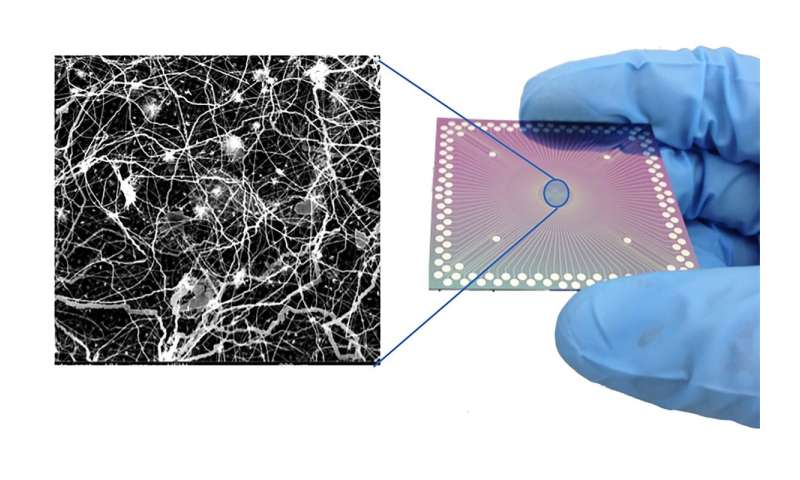
UCLA scientists James Gimzewski and Adam Stieg are part of an international research team that has taken a significant stride toward the goal of creating thinking machines.
Led by researchers at Japan's National Institute for Materials Science, the team created an experimental device that exhibited characteristics analogous to certain behaviors of the brain—learning, memorization, forgetting, wakefulness and sleep. The paper, published in Scientific Reports, describes a network in a state of continuous flux.
"This is a system between order and chaos, on the edge of chaos," said Gimzewski, a UCLA distinguished professor of chemistry and biochemistry, a member of the California NanoSystems Institute at UCLA and a co-author of the study. "The way that the device constantly evolves and shifts mimics the human brain. It can come up with different types of behavior patterns that don't repeat themselves."
The research is one early step along a path that could eventually lead to computers that physically and functionally resemble the brain—machines that may be capable of solving problems that contemporary computers struggle with, and that may require much less power than today's computers do.
The device the researchers studied is made of a tangle of silver nanowires—with an average diameter of just 360 nanometers. (A nanometer is one-billionth of a meter.) The nanowires were coated in an insulating polymer about 1 nanometer thick. Overall, the device itself measured about 10 square millimeters—so small that it would take 25 of them to cover a dime.
Allowed to randomly self-assemble on a silicon wafer, the nanowires formed highly interconnected structures that are remarkably similar to those that form the neocortex, the part of the brain involved with higher functions such as language, perception and cognition.
One trait that differentiates the nanowire network from conventional electronic circuits is that electrons flowing through them cause the physical configuration of the network to change. In the study, electrical current caused silver atoms to migrate from within the polymer coating and form connections where two nanowires overlap. The system had about 10 million of these junctions, which are analogous to the synapses where brain cells connect and communicate.
The researchers attached two electrodes to the brain-like mesh to profile how the network performed. They observed "emergent behavior," meaning that the network displayed characteristics as a whole that could not be attributed to the individual parts that make it up. This is another trait that makes the network resemble the brain and sets it apart from conventional computers.
After current flowed through the network, the connections between nanowires persisted for as much as one minute in some cases, which resembled the process of learning and memorization in the brain. Other times, the connections shut down abruptly after the charge ended, mimicking the brain's process of forgetting.
In other experiments, the research team found that with less power flowing in, the device exhibited behavior that corresponds to what neuroscientists see when they use functional MRI scanning to take images of the brain of a sleeping person. With more power, the nanowire network's behavior corresponded to that of the wakeful brain.
The paper is the latest in a series of publications examining nanowire networks as a brain-inspired system, an area of research that Gimzewski helped pioneer along with Stieg, a UCLA research scientist and an associate director of CNSI.
"Our approach may be useful for generating new types of hardware that are both energy-efficient and capable of processing complex datasets that challenge the limits of modern computers," said Stieg, a co-author of the study.
The borderline-chaotic activity of the nanowire network resembles not only signaling within the brain but also other natural systems such as weather patterns. That could mean that, with further development, future versions of the device could help model such complex systems.
In other experiments, Gimzewski and Stieg already have coaxed a silver nanowire device to successfully predict statistical trends in Los Angeles traffic patterns based on previous years' traffic data.
Because of their similarities to the inner workings of the brain, future devices based on nanowire technology could also demonstrate energy efficiency like the brain's own processing. The human brain operates on power roughly equivalent to what's used by a 20-watt incandescent bulb. By contrast, computer servers where work-intensive tasks take place—from training for machine learning to executing internet searches—can use the equivalent of many households' worth of energy, with the attendant carbon footprint.
"In our studies, we have a broader mission than just reprogramming existing computers," Gimzewski said. "Our vision is a system that will eventually be able to handle tasks that are closer to the way the human being operates."
Adrian Diaz-Alvarez et al. Emergent dynamics of neuromorphic nanowire networks,
Scientific Reports(2019).
DOI: 10.1038/s41598-019-51330-6Citation: Researchers observe brain-like behavior in nanoscale device (2019, December 17) retrieved 30 December 2019 from https://ift.tt/2ErKpUx
This document is subject to copyright. Apart from any fair dealing for the purpose of private study or research, no part may be reproduced without the written permission. The content is provided for information purposes only.
from Hacker News https://ift.tt/2ErKpUx
No comments:
Post a Comment
Note: Only a member of this blog may post a comment.